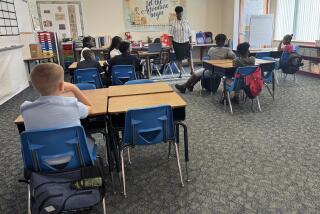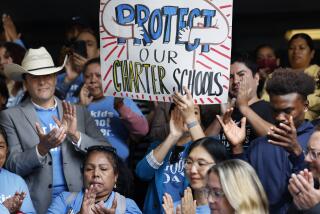Year-Round School Plan Rejected : Education: The Burbank boardâs action puts off a final decision until next year on converting overcrowded Joaquin Miller Elementary.
Heeding skeptical parents, Burbank school board members have rejected a proposal to convert an overcrowded elementary school to a year-round, multitrack schedule, agreeing instead to consider other options over the next year.
The decision, by a 4-1 vote Thursday night, does not mean that the Burbank Unified School District has given up on plans to convert Joaquin Miller Elementary School to year-round instruction.
But the board effectively put off a final decision until next year, while district officials develop a plan to deal with overcrowding and possibly change the school schedule starting in the summer of 1994.
District officials had initially proposed changing the schedule in time for the start of the 1993-94 school year. After angry parents voiced opposition at public hearings, Supt. Arthur Pierce asked the board on Nov. 5 to back year-round instruction at Miller, but to postpone implementing it for at least a year.
On Thursday night, board members went beyond Pierceâs request and decided to put off any decision until next year. But the district will carry on with plans to apply for state air-conditioning funds for schools that convert to year-round schedules.
Before the vote, Pierce urged the board to make a commitment to a year-round calendar at Miller--which would be the districtâs only year-round school--in order to give teachers, administrators and parents until the summer of 1994 to prepare for the change.
After studying several year-round programs, Pierce said those districts that made the transition with the fewest problems had made a firm commitment to conversion and then gave employees and the community a year or more to adapt.
Conversely, âthose districts which have the most trouble are those that drag out the process,â Pierce said.
But several board members said it was important to gain community support for any proposed schedule change by taking other options seriously and involving more affected parents in the decision.
âWe donât want to lock ourselves into a plan,â said board member Elena Hubbell, who modified Pierceâs proposal to delete any commitment to year-round instruction. âWeâre still keeping ourselves open to other options.â
Board member Audrey Hanson cast the lone vote against Hubbellâs changes.
The board also voted to establish a committee of educators, administrators and parents from each of the districtâs 11 elementary schools to study year-round education.
Miller School at Providencia Street and Kenneth Road was the only campus under consideration for a year-round schedule. It was designed in 1957 for about 400 students from kindergarten through sixth grade but now houses about 800 from kindergarten through fifth grade with the use of 13 portable bungalows, which take up most of the playground area.
In several recent public hearings, parents of Miller students and members of parent-teacher groups at other schools have expressed concern that the school would be out of sync with the rest of the district, which would remain on a traditional schedule.
District officials said busing children to other schools is unfeasible because most Miller students live within a few blocks of their school. The neighborhood, in northeast Burbank, has seen explosive growth in apartment buildings in the past decade.
All of the elementary schools near Miller are at or near capacity, according to Pierce, and redrawing Millerâs boundaries would set off a domino effect that would ultimately force most students in the city to be bused to elementary schools outside their neighborhoods.
Eventually, other schools or possibly the entire district might have to convert to year-round schedules as enrollments grow over the next 10 to 20 years, Pierce said.
More to Read
Sign up for Essential California
The most important California stories and recommendations in your inbox every morning.
You may occasionally receive promotional content from the Los Angeles Times.










